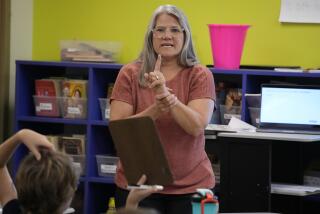Book Review : Capitalism Plus Math: It All Adds Up
- Share via
Capitalism & Arithmetic: The New Math of the 15th Century by Frank J. Swetz (Open Court Publishing Co.: $33.95, hardcover; $16.95, paperback; 345 pages)
St. Ambrose, who was the teacher of St. Augustine, lived in the 4th Century and is believed to be the first person in history who could read silently to himself without moving his lips.
This skill so impressed Ambrose’s contemporaries that they thought he was the smartest person alive. In his “Confessions,” Augustine even comments on Ambrose’s silent-reading ability. It was a remarkable feat for its day.
Nowadays people learn to read to themselves as young children and seem to accomplish it without much trouble. You are probably doing it even now, and you never give it much thought.
Another skill that modern people learn in grade school is the ability to do simple arithmetic: addition, subtraction, multiplication and division. (Perhaps it would be more accurate to say that people are taught these skills in grade school; whether they learn them is another matter.)
New to the Human Repertoire
But, as with silent reading, simple arithmetic, which we now take for granted and hardly think about, has not always been part of the human repertoire. In fact, it was not until the late Middle Ages and early Renaissance that Arabic numerals (1, 2, 3, 4) became standard and the ways of manipulating them became generally known. At the time, this knowledge was considered higher learning.
In 1478, in the Italian town of Treviso north of Venice, a small book was published that explained the basic operations of arithmetic. Its author is unknown, but the book has a special place in the history of mathematics and of thought. It is the earliest known printed mathematics book in the West.
The “Treviso Arithmetic,” as it is called, has several additional claims to fame. It was written in Italian, not Latin, indicating that it was meant for a general readership rather than a scholarly one.
Furthermore, the problems and examples the book gives are practical, mercantile problems, problems of business and trade. Venice was a thriving port and center of commerce, and people wanted to learn to add and subtract so they could keep business accounts straight.
Not Everyone’s Cup of Tea
Now, the history of mathematics may not be everyone’s cup of tea, but “Capitalism & Arithmetic” places that history in a much broader social context. About half of the book contains an English translation of the “Treviso Arithmetic,” which is made available here for the first time, and the other half contains a fascinating account of the effect of arithmetic on business and, ultimately, on the structure of society.
For it is the thesis of the book that the ability to do arithmetic--simple sums, if you will--led to the development of accounting and capitalism. The author, Frank J. Swetz, a historian of mathematics, argues that arithmetic facilitated the development of trade, money systems and weights and measures, all of which made possible the socio-economic system we all know and love.
There were obviously many other factors at work in 15th-Century Italy that gave birth to the modern world. It is no accident that the Renaissance itself and all of the social and intellectual changes that it wrought started in Italy. Volumes, many volumes, have been written on this subject.
But by focusing on the influence of simple mathematics, Swetz makes an important and useful contribution to our understanding of what happened and why. And because the “Treviso Arithmetic” is full of real-world problems involving actual objects of commerce, Swetz also gives a glimpse of what daily life was like in that period.
The Need for Solutions
The role that Swetz assigns to mathematics in Renaissance Italy is consistent with the role that mathematics has played from ancient times to the present day. The development of mathematics has always been spurred by a need to solve practical problems. Geometry, for example, which Euclid turned into a formal, logical system, got its start as a way to reckon with areas and plots of land. Our number system is based on powers of 10 because people began counting on their fingers.
But the relationship between mathematics and the world works both ways. Practical concerns affect the development of mathematics, to be sure, but mathematics affects our view of the world. That is what happened in the Renaissance and the centuries immediately following, as Swetz makes clear. And that is what continues to happen today, as social scientists, economists and others seek to quantify things and believe that truth lies in adding things up.
The computer has accelerated this trend, which started 500 years ago. Giving something a number adds to its credibility even if the number leaves out more truth than it includes.
Swetz’s book serves many purposes. For the historically and scholarly minded, it makes the “Treviso Arithmetic” available. It is also a good social snapshot of an era. Most important, it shows where our faith in numbers comes from, a faith that is an inextricable part of contemporary thought and that applies much more broadly than keeping the books.
Like reading silently and doing arithmetic, we don’t usually stop to consider where this world view came from. We just accept it as one of the givens of life.


